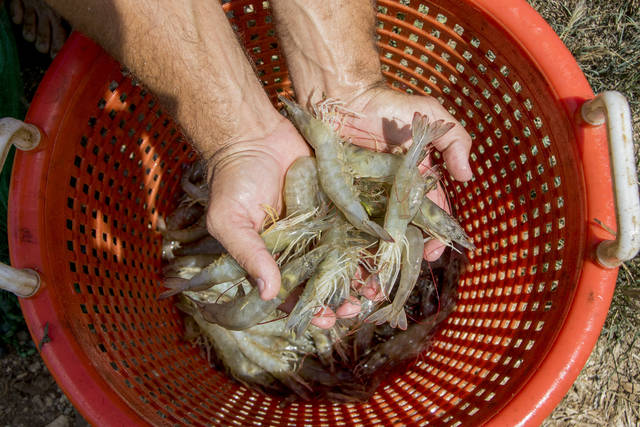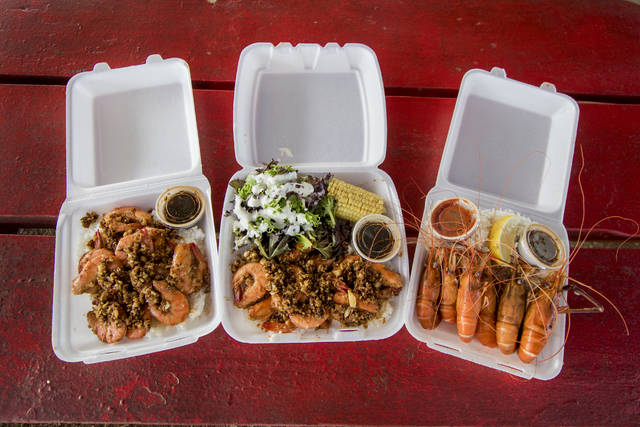Gone are the days of stopping by a roadside stand to buy live Kahuku shrimp or prawns that had been raised mere steps away.
Today, true Kahuku shrimp and prawns are served only at the distinctively red Romy’s Kahuku Prawns and Opens in a new tabShrimp Opens in a new tab, and a handful of other restaurants on Oahu. None are sold to take home.
What happened? Of the handful of North Shore stands that used to sell live shrimp, only Romy’s remains in business. The stands declined as the number of Oahu’s aquaculture farms dropped.
Romy Aguinaldo, founder of Romy’s, stopped selling live shrimp and prawns from his ponds in 2004, choosing to cook up most of them to serve at his own restaurant. Most of the other shrimp farms in the area were short-lived, lasting only 18 months or so, due to shrimp diseases, partnership problems or other causes, Aguinaldo said.
Kauai shrimp, meanwhile, have eclipsed Kahuku shrimp in availability statewide, though you won’t find a roadside stand selling them on Oahu.
Romy’s serves 60 to 80 pounds of shrimp every weekday, 100 pounds a day on weekends, “and double that on holidays,” said Rusty Arneson, Aguinaldo’s son-in-law, who now runs the farming operation while Aguinaldo focuses on the overall business.
SHRIMP VS. PRAWN: WHAT’S THE DIFFERENCE?
>> Shrimp and prawns are both crustaceans with exoskeletons and 10 legs.
>> Prawns live primarily in fresh water, while shrimp are saltwater creatures.
>> Prawns have claws on three pairs of legs, and the pincers on the second set are usually bigger than those on the front. Shrimp have two pairs of clawed legs, with the front pincers usually the largest.
>> Sections of prawn shells overlap, the first over the second, second over the third, and so on. On a shrimp, the second segment of shell overlaps the first and third. A shrimp body also has a bend in it.
“Ninety percent of our product goes to our restaurant,” Arneson said.
The other 10 percent of Romy’s yield goes to Roy’s Beach House at Turtle Bay Resort, Chart House in Waikiki, and to a distributor who delivers the Kahuku crustaceans to “a couple” of Chinese restaurants, he said.
That means all those popular North Shore shrimp trucks and stands are getting their crustaceans from elsewhere.
“The No. 1 question, for sure, is ‘Do you supply the other shrimp restaurants in Kahuku, or even the North Shore, Haleiwa?’ and the answer is, ‘No,’” Arneson said.
“The rest of the guys are not growing their own shrimp,” confirmed Todd Low, Aquaculture Development Program manager for the state of Hawaii Department of Agriculture.
Shrimp-related aquaculture operations that remain on Oahu now primarily focus on broodstock, or shrimp that will produce larvae, both Low and Arneson said.
Low credits Aguinaldo with spawning a whole industry, though Aguinaldo said Giovanni’s was the first Kahuku shrimp truck.
“What saved (Aguinaldo) was that he was astute enough to sell it (cooked) and get the higher price,” Low said. “Just growing shrimp, you can be lucrative, but you need to have some scale,” he said.
The addition of a food-service outlet to sell cooked shrimp adds value, and hence adds to the price-per-pound, Low observed.
Romy’s is like an iceberg in Kahuku. The restaurant and perhaps a third of the 880-acre aquaculture farm are visible from Kamehameha Highway, but much more is beyond view.
Romy’s raises shrimp and prawns year-round in ponds. The creatures live out their lives at the aquaculture operation, beginning at the hatchery. The farm also raises two varieties of tilapia.
Most of Aguinaldo’s shrimp and prawns used to be delivered to restaurants, while some were reserved for his roadside stand, but then customers started encouraging him and his wife, Terry, to offer cooked versions for sale. Pretty soon the demand was such that Aguinaldo made the difficult decision to focus on his restaurant business, where his wife and daughter work, while his son-in-law tends to the farm.
The business is open 365 days a year, and is especially busy on weekends and holidays, so the wait for a plate of buttery garlic shrimp or other dish can be 45 minutes or more. A little-known secret is that Romy’s now allows customers to order ahead by phone, Arneson said.
There used to be more aquaculture farms on Oahu, so others vendors could sell live shrimp and prawns on the roadside.
“I remember that, from small-kid time,” said Taylor Kellerman, director of Diversified Agriculture and Land Stewardship at Kualoa Ranch.
The ranch cultivates oysters and saltwater shrimp, and after a break for some infrastructure changes, expects to be back in full production this month, Kellerman said.
Kualoa Ranch Opens in a new tab sells its shrimp and oysters to restaurants, but also sells them, as well as the many other crops raised on the property, to the public.
When shrimp are in production, the visitor center tries to have fresh stock on hand Mondays, Wednesdays and Fridays “but we always have frozen shrimp available” as well as oysters year-round, and beef, he said.
Customers concerned about driving all the way to Kualoa only to find the visitor center sold out can order ahead online, by email, or by phone to reserve a quantity.
The push to develop aquaculture as part of a move to diversify agriculture beyond sugar cane and pineapple was big in the 1980s, especially for high-value aquaculture crops like oysters.
However, Taylor “Tap” Pryor’s Systemculture Seafood Plantations at Kahuku never quite boomed as hoped, and a couple owners later, the former oyster farm is now part of Romy’s operation.
By 2024, Romy’s will have to move, as the facility’s leased land will be added to the adjacent James Campbell National Wildlife Refuge.
“We’re working with him on some ideas, and assisting him with relocating,” Low said.
As with any farming, the work is hard, but with shrimp and prawn production, “there’s great potential,” Low said. “Shrimp is the No. 1 imported seafood into America.
“We are hopeful that the industry can grow, but everything comes back to capital and having the right expertise … being able to withstand the hard times.
“Romy has been able to do that. Those others have not.”
Catch your own: Tour operator Glenn Oshiro has an agreement with Romy’s Kahuku Prawns and Shrimp to bring small groups to Romy’s ponds to fish for prawns, small carp and other fish. Oshiro grills his customers’ larger catches for them, before leading them to Romy’s for full lunches. Call GT International at 754-3785 or visit hawaiiebitsuri.com Opens in a new tab (website is in Japanese).










